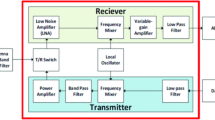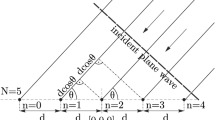Abstract
With the advent of fifth Generation of cellular communication with its key features that superior over all the precedent generations. However, there are some challenges need to be taken into consideration. The main crucial part of communication system is the receiver and as it is known there are two main types of receivers which can be used to demodulate the signals and recover the transmitted data. In this paper, we used those two types of algorithm receivers which are the Non-Coherent and Coherent receivers. They are firstly demonstrated in details in accordance with receiver specification design and then moved to the practical side of implementation. In which novelty of our work is highlighted, by carrying out those different algorithms on the ADSP 21364 SHARC board where initially sampling the received DPSK signal, design the Bandpass and lowpass digital filtering respectively and all to be compiled by Analog Devices VisualDSP + + software that is programmed by C language prior to download to the ADSP Board chip. The same algorithm is followed in the frame synchronization for both of them by detecting the message through distinguishing the preamble of the message “ + + + + ” data which is before the 72 bytes (real message).Then that actual message will be stored and dumped to the memory and displayed to ensure from the received message whether it is corrupted with errors or not. However, it is clearly noticed that the Coherent receiver is more efficient than the Non-coherent, but it still a bit expensive because used double look-up tables for cosine and sine in IQ converter. Finally, coherent receiver with Costas loop algorithm was implemented as well to improve the previous differential detection scheme.




































Similar content being viewed by others
Data Availability
The most datasets generated and/or analysed in this study are comprised in this submitted manuscript. The other datasets are available on reasonable request from the corresponding author with the attached information.
Code Availability
The code used for analysis in this study is available on reasonable request from the corresponding author with the attached information.
References
Al-Dujaili, M., & Al-Dulaimi, M. (2023). Fifth-generation telecommunications technologies: Features, architecture. Challenges and Solutions. Wireless Pers Commun, 128, 447–469. https://doi.org/10.1007/s11277-022-09962-x
Chiueh, T. D., & Tsai, P. Y. (2007). OFDM baseband receiver design for wireless communications. Wiley.
Khan, M. G. (2009). On coherent and non-coherent receiver structures for impulse radio UWB systems (Doctoral dissertation, Blekinge Institute of Technology).
"Phase-shiftkeying." Princeton.edu.N.p.,n.d.Web3Jan.2014. <http://www.princeton.edu/~achaney/tmve/wiki100k/docs/Phase-shift_keying.html>
"ADSP-21364 EZKIT Manual." ADSP-21364 EZKIT Manual. N.p., n.d. Web.16 Dec. 2013. <http://www.staff.ncl.ac.uk/charalampos.tsimenidis/EEE8091/EEE8091-MO1.html>
Tisimenidis, C. (2013). Implementation of wireless receiver algorithm school of electrical and electronic engineering. University of Newcastle.
Liu, W., Zhou, X., Durrani, S., & Popovski, P. (2017). A novel receiver design with joint coherent and non-coherent processing. IEEE Transactions on Communications, 65(8), 3479–3493. https://doi.org/10.1109/TCOMM.2017.2698475
Cheng, Ju., Liu, Na., Li, C., Chi, Z., Zhang, Z., & Chen, X. (2018). Low-complexity blind in-phase/quadrature imbalance compensation and field-programmable gate array realization for coherent receivers. Optical Engineering, 57(11), 116101. https://doi.org/10.1117/1.OE.57.11.116101
Gamal, H., Ismail, N. E., Rizk, M. R. M., Khedr, M. E., & Aly, M. H. (2019). A coherent performance for noncoherent wireless systems using adaboost technique. Applied Sciences, 9(2), 256. https://doi.org/10.3390/app9020256
Calvo-Palomino R., Cordobés H., Ricciato F., Giustiniano D., Lenders V. (2019) Collaborative wideband signal decoding using non-coherent receivers, 2019 18th ACM/IEEE International Conference on Information Processing in Sensor Networks (IPSN), pp. 37–48, https://doi.org/10.1145/3302506.3310387
Yan Zhao, Chen Shi, Yang, Du, Zang, Wang, Chen, Wang and Zhang, Low-complexity and joint modulation format identification and OSNR estimation using random forest forflexiblecoherentreceivers, Optics Communications, Volume 457,2020,124698,ISSN 0030–4018 https://doi.org/10.1016/j.optcom.2019.124698
Abdulzahra M, Al-Dulaimi A (2021). The comparative performance of 16 QAM/BPSK—OFDM scheme over frequency selective known and unknown multipath besides AWGN channel. 2021 Palestinian International Conference on Information and Communication Technology (PICICT), pp. 129-134, https://doi.org/10.1109/PICICT53635.2021.00033
Afisiadis, O., Li, S., Tapparel, J., Burg, A., & Balatsoukas-Stimming, A. (2021). On the advantage of coherent lora detection in the presence of interference. IEEE Internet of Things Journal, 8(14), 11581–11593. https://doi.org/10.1109/JIOT.2021.3058792
ZigBee Specification FAQ. ZigBee Specification FAQ. N.p., n.d. Web. 6 Dec. 2013. <http://www.zigbee.org/Specifications/ZigBe
MetaGeek. Visualize your wireless landscape. MetaGeek. N.p., n.d. Web. 2 Jan. 2014. <http://www.metageek.net/control4/zigbee-channels/>
Nawaz, S. J., Sharma, S. K., Mansoor, B., Patwary, M. N., & Khan, N. M. (2021). Non-coherent and backscatter communications: Enabling ultra-massive connectivity in 6G wireless networks. IEEE Access, 9, 38144–38186. https://doi.org/10.1109/ACCESS.2021.3061499
Vekariya V, Pandey A K (2023). Non-coherent and backscatter communications: towards ultra-massive communication in 6g wireless connections, 2023 International conference on artificial intelligence and smart communication (AISC), Greater Noida, India, , pp. 1282–1285, https://doi.org/10.1109/AISC56616.2023.10085275
Huang, J., Lan, M., Zhang, H., Huang, C., Zhang, W., & Cui, S. (2020). Design of noncoherent communications: From statistical method to machine learning. IEEE Wireless Communications, 27(1), 76–83. https://doi.org/10.1109/MWC.001.1900284
Cai, X., Huang, C., An, J., Xu, W., Wang, L., & Yuen, C. (2023). Non-coherent chaotic communications aided by RIS: A performance-enhanced approach. IEEE Communications Letters, 27(6), 1614–1618. https://doi.org/10.1109/LCOMM.2023.3268031
Cai, X., et al. (2023). Toward RIS-aided non-coherent communications: A joint index keying M-ary differential chaos shift keying system. IEEE Transactions on Wireless Communications, 22(12), 9045–9062. https://doi.org/10.1109/TWC.2023.3268071
Funding
This research was not supported by any Funding Agency.
Author information
Authors and Affiliations
Contributions
Mohammed Abdulzahra Al-dulaimi and Mohammed Jawad Al-Dujaili conceived and designed the study performed experiments and collected data analyzed and interpreted the data wrote the manuscript. reviewed and approved the final version.
Corresponding author
Ethics declarations
Conflict of interest
The authors have no conflict of interest to disclose.
Additional information
Publisher's Note
Springer Nature remains neutral with regard to jurisdictional claims in published maps and institutional affiliations.
Rights and permissions
Springer Nature or its licensor (e.g. a society or other partner) holds exclusive rights to this article under a publishing agreement with the author(s) or other rightsholder(s); author self-archiving of the accepted manuscript version of this article is solely governed by the terms of such publishing agreement and applicable law.
About this article
Cite this article
Al-Dulaimi, M.A.A., AL-Dujaili, M.J. Design and Implementation of 5G Wireless Receiver Algorithms on the DSP Board. Wireless Pers Commun 135, 2331–2354 (2024). https://doi.org/10.1007/s11277-024-11161-9
Accepted:
Published:
Issue Date:
DOI: https://doi.org/10.1007/s11277-024-11161-9




